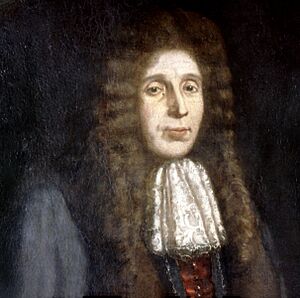Robert Aske (merchant) facts for kids
Quick facts for kids
Robert Aske
|
|
|---|---|

Alderman Robert Aske
|
|
| Born |
Robert Aske
24 February 1619 |
| Died | 27 January 1689 (aged 69) London, England
|
| Occupation | Silk merchant |
| Title | Master Haberdasher |
| Relatives | Aske baronets |
Robert Aske (born 1619, died 1689) was an English businessman from the 1600s. He was a kind person who gave a lot of money to help others. He was a merchant (a trader) and a haberdasher (someone who sold fabrics and sewing items). He also served as an Alderman in the City of London.
Aske is best known for the charity he started. This charity now runs two excellent schools in Elstree: Haberdashers' Boys' School and Haberdashers' School for Girls. It also supports other schools in the London area.
Contents
Robert Aske's Life Story
Robert Aske was originally from Scarborough in Yorkshire. His father, also named Robert Aske, was a wealthy cloth merchant. Young Robert became an apprentice to John Trott, a London haberdasher who also traded with the British East India Company.
In 1643, Aske became a full member of the Haberdashers' Company, a powerful trade group. He was chosen as an Alderman for the City of London in 1666. Later, in 1685, he became the Master of the Haberdashers' Company.
His Investment in the Royal African Company
From 1671, Robert Aske owned shares worth £500 in the Royal African Company. This company was involved in the transatlantic slave trade. He was one of 198 shareholders and had one vote in the company's decisions.
In 1687, King James II removed Aske from his position as Master of the Haberdashers' Company. This happened because Aske was a Protestant, and the King, who was Catholic, no longer trusted him.
Aske's investment in the Royal African Company was a small part of his total wealth. In recent years, many old European organizations have looked back at their history, especially their connections to the slave trade. The schools founded by Aske's charity also reviewed their past. Because of this connection, the name "Aske" was removed from the two Haberdashers' Schools at Elstree in 2021. However, the charity that runs the schools still uses his name.
His Amazing Charity Work
| Robert Ask's Charity Act 1690 | |
|---|---|
| Act of Parliament | |

|
|
| Long title | An Act for settling a charity given by Robert Aske Esq. to the Company of Haberdashers of London. |
| Citation | 2 Will. & Mar. Sess. 2. c. 18 |
| Dates | |
| Royal assent | 20 December 1690 |
| Other legislation | |
| Amended by | Haberdashers' Aske's Charity Act 2016 |
|
Status: Amended
|
|
| Haberdashers' Aske's Charity Act 2016 | |
|---|---|
| Act of Parliament | |

|
|
| Long title | An Act to make provision regarding the identity of the corporators of the Aske Corporation and the status of the Corporation; to provide for property held on trust by the Corporation to be subject to the same legal controls as apply generally to charity property; to make formal provision for internal procedures; and for related purposes. |
| Citation | 2016 c. ii |
| Dates | |
| Royal assent | 15 September 2016 |
| Other legislation | |
| Amends | Robert Ask's Charity Act 1690 |
|
Status: Current legislation
|
|
| Text of statute as originally enacted | |
Even though Robert Aske was married twice, he did not have any children. He decided to leave most of his large fortune, about £32,000, to the Haberdashers' Company. This was the company that helped him start his career.
He wanted £20,000 to be used to buy land near the City. On this land, a "hospital" (which meant almshouses for poor people) would be built for 20 poor members of the Worshipful Company of Haberdashers. Also, a school for 20 sons of poor members of the company would be built. The remaining £12,000 helped create the Haberdashers' Aske's Foundation. The Haberdashers' Company still acts as a trustee for this charity. The charity was officially recognized by a special law passed in 1690.
Robert Aske's Lasting Legacy
In 1692, Almshouses and a school, Haberdashers' Aske's Boys' School, were built in Hoxton. These buildings were designed by Robert Hooke. The charity also bought more land in Kent to provide a steady income.
The original buildings were taken down in 1824 and rebuilt in 1825. In 1874, the almshouses were closed so the school could grow. It expanded to teach 300 boys and 300 girls. Two more schools were opened in Hatcham, Surrey, in 1875.
Haberdashers' Aske's School in Hoxton moved in 1898. The boys' school went to Hampstead, and the girls' school went to Acton. The boys' school later moved to Elstree in 1961. The girls' school joined them in 1974, opening on a nearby site. The Hatcham schools are now combined into one state school, called Haberdashers' Hatcham College.
See also

